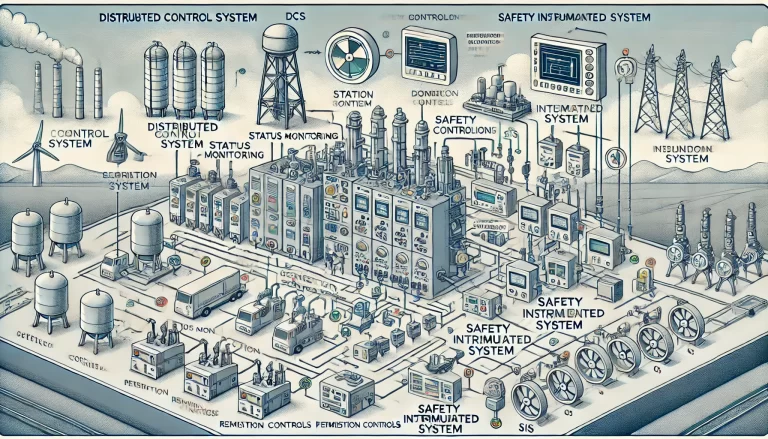Before performing a shutdown of a Distributed Control System (DCS), it is essential to conduct a thorough inspection to ensure a smooth and risk-free process. Below is a detailed checklist for pre-shutdown inspection:
1. Data Backup
Purpose: To prevent data loss and ensure quick recovery in case of system failure after the shutdown.
- Verify that the configuration data, historical data, and user settings are fully backed up.
- Ensure the backup files are stored in a secure location.
- Confirm the integrity of the backup files by performing a test restore, if possible.
- Check the storage medium for any potential faults or failures.
2. Hardware Inspection
Purpose: To ensure all hardware components are in good working condition before shutdown.
- Inspect controllers, I/O modules, power supply modules, and communication modules.
- Verify there are no active alarms or fault indicators on hardware components.
- Check the status of LED indicators on each module to ensure normal operation.
- Look for physical damage, loose connections, or visible signs of wear.

3. Network Connectivity
Purpose: To ensure stable and reliable communication between DCS components and peripheral devices.
- Verify the status of network cables, switches, and routers.
- Check for any network alarms or error logs in the network management system.
- Perform a connectivity test between key system nodes.
- Confirm redundancy in the network setup, if applicable.
4. Software Status
Purpose: To confirm that the system software is functioning correctly and free of errors before shutdown.
- Check the health status of the operating system and DCS application software.
- Look for any unresolved error messages or warnings in the software logs.
- Verify that the software versions are up-to-date.
- Ensure critical services are running and stable.
5. Operational Logs
Purpose: To review past incidents and identify any unresolved issues before shutdown.
- Review recent system operational logs for any abnormalities or recurring issues.
- Document any ongoing faults and ensure they are addressed before shutdown.
- Verify log retention settings to ensure no critical data will be lost.
6. Power Supply
Purpose: To guarantee uninterrupted power supply during shutdown and potential recovery scenarios.
- Inspect the power supply units and ensure all connections are secure.
- Check the status and capacity of the UPS (Uninterruptible Power Supply) system.
- Ensure UPS batteries are sufficiently charged and within operational parameters.
- Test backup power systems, if available.
7. Field Device Communication
Purpose: To verify the functionality and communication status of connected field devices.
- Perform communication tests with all field devices (e.g., sensors, actuators).
- Confirm that real-time data transmission is stable and accurate.
- Check device calibration where applicable.
- Document any devices showing communication errors.
8. Security Measures
Purpose: To ensure system integrity and protection against unauthorized access.
- Verify firewall settings and ensure no unauthorized access points exist.
- Check user permissions and ensure only authorized personnel have access.
- Ensure recent security patches are installed on relevant systems.
- Disable unnecessary services or ports to minimize vulnerabilities.

9. Cooling and Ventilation
Purpose: To prevent overheating of critical hardware components.
- Check the status of cooling fans in server cabinets and control units.
- Ensure proper ventilation and airflow within the equipment racks.
- Clean or replace air filters if necessary.
- Monitor system temperature levels for any abnormalities.
10. Cleanliness and Maintenance
Purpose: To avoid hardware failure caused by dust, debris, or contamination.
- Inspect control cabinets and hardware modules for dust accumulation.
- Perform cleaning where necessary, following proper safety procedures.
- Ensure equipment is free from any obstructions affecting performance.
11. Spare Parts Inventory
Purpose: To ensure availability of critical spare parts during shutdown or recovery.
- Verify the availability of essential spare parts (e.g., power modules, controllers, cables).
- Check the condition and expiration dates of stored spare parts.
- Document inventory levels and order replacements if required.
12. Emergency Response Plan
Purpose: To be prepared for unexpected failures or critical incidents during shutdown.
- Review the emergency response plan for the shutdown period.
- Ensure all team members are aware of their roles and responsibilities.
- Verify availability of emergency contact details for key personnel.
- Conduct a simulation or briefing to address potential scenarios.

13. Final Verification
Purpose: To ensure every step of the checklist has been completed satisfactorily.
- Perform a final walkthrough of all inspection items.
- Cross-check documentation for completeness.
- Obtain sign-off from the responsible authority or team leader.
By meticulously following this checklist, the DCS shutdown process can be executed efficiently, minimizing risks and ensuring a seamless restart when required.
